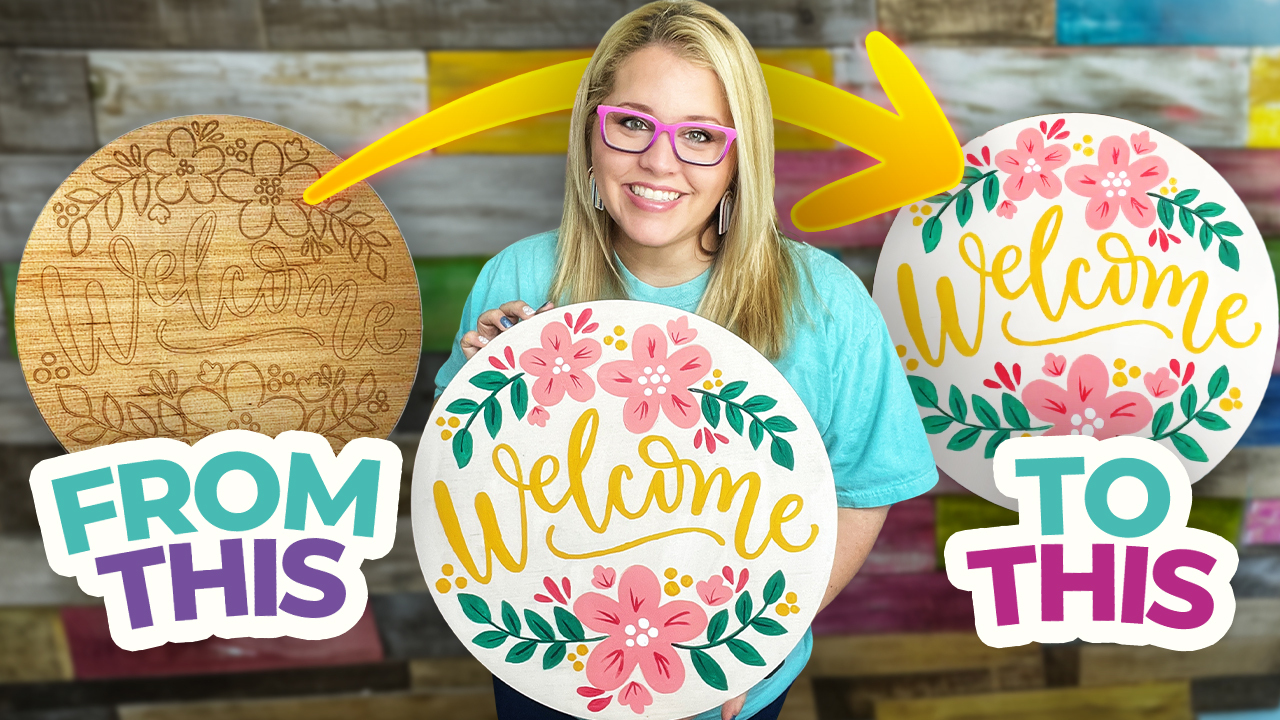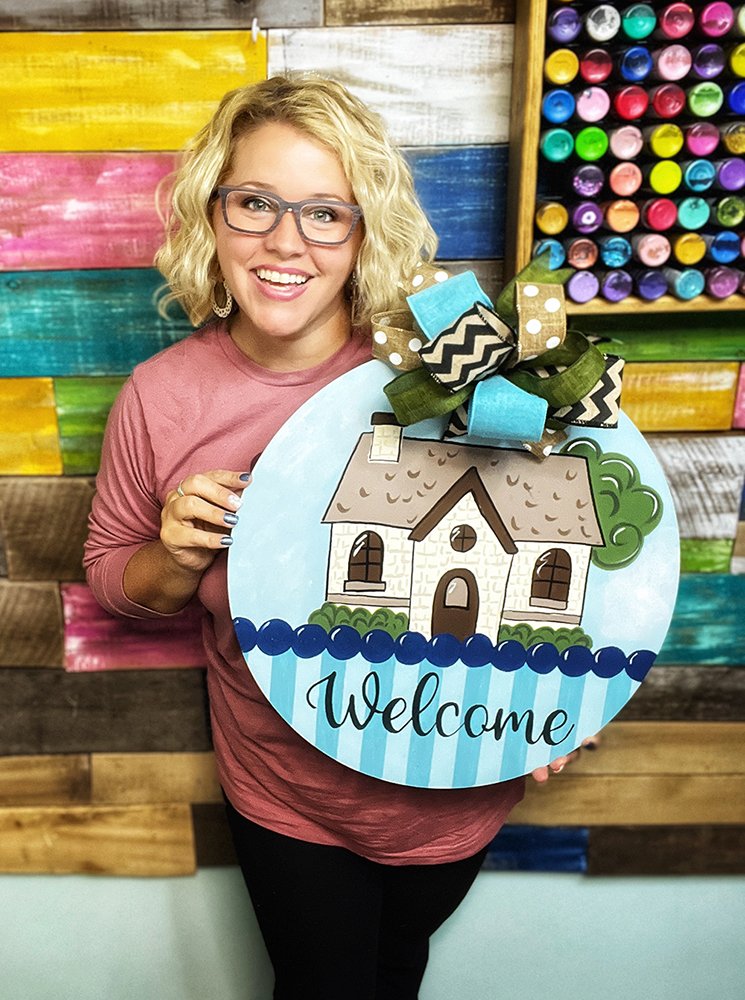Some of the links shared in this blog post are affiliate links. This means I make a small commission when you purchase through these links at no extra cost to you. All opinions and reviews shown are honest and my own. Thank you for supporting my small business!
It may be a bit chilly outside, but I’m ready to look ahead to the beautiful spring weather! If you’re feeling the same, then you’ll love the tutorial I have for you in this post!
This welcome door hanger with flowers design is perfect for spring and adds a touch of warmth and charm to any front door! To get the tutorial, simply watch the video, or you can read the notes below!
Supply List for Your Floral Welcome Door Hanger
Check your craft stash for these supplies, or if you don’t have them, you can purchase them from my shop, my Amazon storefront, or your local craft store!
- Welcome Door Hanger Blank, which you can find in the shop
- Welcome Door Hanger Template, also in the shop
- Graphite Paper for transferring the template onto the wood
- DecoArt Acrylic Craft Paints (I used the following colors, but you’re more than welcome to swap them out for something else!)
- Light Buttermilk
- Melon
- Watermelon Slice
- Jewel Green
- Black
- White
- Sunset
- Flat-tip paintbrush
- Round-tip paintbrush
- Filbert paintbrush
- Water Cup
- Paper Towels or baby wipes for blotting excess paint and cleaning up spills
- Sealer for protecting your finished door hanger once it’s complete
Step 1: Prep Your Wood Blank
Before we start painting, you need to prepare your wood blank. If you purchased a pre-cut blank from the shop, it’s already sanded and ready to go. If you’re cutting your own, make sure to sand the edges smooth.
Not sure how to cut out your own wood blank? My free mini-course for beginners has a few tips for you!
Step 2: Transfer the Template
If you purchased the wood blank for this project in our shop, you can skip this step! The lines will already be etched directly into the wood. If you’re cutting your own wood blank, and have a laser machine, you can also etch those lines in yourself instead of tracing it with paper.
But if you’re using the template to trace with graphite paper, follow these instructions:
- Place your carbon or graphite paper on top of your wood blank, with the dark side facing down.
- Place your printed template on top of the carbon paper and secure it with tape.
- Carefully trace over the lines of the template using a pencil.
This will transfer the design directly onto the door hanger, giving you a “stencil” for when you paint.
Step 3: Paint the Background of the Blank
Start by painting the background with your light buttermilk color. Use a flat tip or filbert brush to apply a smooth, even coat of paint.
If you notice your paint is too thick, you can easily thin it out with a drop of water!
Make sure you cover the entire blank with your base coat — the other colors are dark enough that they won’t show through, and the etched lines (or ones you traced with the graphite paper) will still show through the base coat!
Step 4: Paint the Flowers
Here comes the fun part — painting the flowers! Don’t be intimidated by the details. It really just comes down to using the right brush. And because there are several types of flowers and foliage on this design, I’ve outlined which brush you need for each one!
- Coral Flowers: Use a Filbert brush for a smooth finish.
- Flower Buds: Use the watermelon slice color and a round tip brush for these, as they’re smaller and require more precision.
- Greenery: Take your jewel green color and a flat tip or Filbert brush to paint in the leaves.
Want to create more dimension? Add a touch of black paint to create a slightly darker shade. Then you can paint thin lines up the center of each petal, connecting them to the stem for a more realistic look.
Step 5: Add the Details
Now, let’s bring in those small details!
- White Dots: Use a filbert brush to dab small white dots in the center of each flower.
- Yellow Dots: Using the same technique, add small yellow dots around the white dots.
- Sprigs: Switch back to the watermelon slice color and use a thin round tip brush to add delicate sprigs (the lines bouncing off the flowers!
Once you have the above done, wait for everything to dry. You can always use a hair dryer on low heat if you want to speed up the process!
Add the Lettering
Once dry, you can start painting the lettering! Use the sunset gold (or marigold) color and a filbert brush to get those smooth lines. Don’t focus so much on getting it perfect as you do keeping your arm steady.
Remember, slow and steady wins the race!
Step 6: Add the Finishing Touches to Your Door Hanger
Once your paint is completely dry, you can add a sealer if you want to protect your door hanger. I have a tutorial on how to do that here!
After your door hanger is dry, you’re all done! Now you have a beautiful and welcoming door hanger. Hang it on your front door, front porch, or put it in your classroom — there are so many ways to display it!
Learn more about Door Hanger Making on Our Cruise!
If you loved this tutorial and want even more amazing door hanger designs, join me on the Painter’s Clubhouse Crafting Cruise!

You’ll learn new techniques, get inspired by other creative crafters, and create beautiful door hangers while sailing the seas. It’s the ultimate crafting retreat!
Interested in signing up? Click here to learn more and secure your spot — bookings close February 20th!



0 Comments